Trimming and Crust Selection represent the final stage of the Beam House section and are among the most important quality control processes in Iran’s leather industry. At this stage, dried leather is refined, uneven or excess edges are removed, and each piece is carefully inspected and graded to prepare it either for finishing or for direct release to the market.
After drying and toggling, leather edges typically display irregular cuts, remnants of previous processing, or minor defects. During the trimming process, these excess parts are removed with specialized precision cutting tools, ensuring that the shape and dimensions of the leather are clean, uniform, and in line with production standards. This not only improves the appearance of the leather but also reduces waste in subsequent cutting or manufacturing stages.
Following trimming, the hides undergo crust selection. In this step, skilled inspectors examine each piece of leather for uniformity of color, softness, grain quality, surface texture, and the absence of defects such as scars or stains. Based on this evaluation, leathers are graded into different categories:
- Grade 1 (Premium): Suitable for luxury leather products such as export-quality handmade bags, fine shoes, and high-end leather garments.
- Grades 2 and 3 (Medium): Suitable for general-purpose products, automotive interiors, or furniture.
- Lower Grades: Used for industrial applications or products that involve heavy surface coating or processing.
Crust selection plays a key role not only in quality control but also in inventory management and production optimization. This stage ensures that each piece of leather is directed toward the most suitable product line according to its quality, thereby reducing material waste and guaranteeing that the final products meet both domestic and international market standards.
Key characteristics of the trimming and crust selection process in Iran’s leather industry:
- Removal of excess or uneven edges to create uniform shape
- Manual and detailed inspection of dried leather (crust) for grading
- Evaluation based on softness, texture, grain quality, and potential defects
- Categorization of leathers for end uses ranging from luxury to industrial
- Ensuring consistent quality and preparation for final production stages


No comments yet.